Increases in average hourly earnings accelerate sharply for private sector Production and Nonsupervisory Employees.
By Wolf Richter for WOLF STREET.
The employment data for October shows a decent job market, with a decent increase in jobs, despite the strikes that hit manufacturing, in line with a normal pre-pandemic job market, but off the levels of the super-tight labor market coming out of the pandemic. The household survey showed an increase in workers on salaries and wages, but a decline in the number of self-employed, and a big drop in part-time workers. And hourly earnings of nonsupervisory workers jumped at a rate that confirms 4%-plus year-over-year wage growth. So this is what we’ll look into now.
The strikes hit manufacturing employment as they ripple from factories through the supply chains. In October, employment in manufacturing fell by 35,000 jobs, with 33,000 of them in motor vehicles and parts, “largely due to strike activity,” according to the BLS report today. When those people return to work, those jobs are going to re-appear in the data for a little bump.
I’m going to post a separate article with lots of employment charts by industry category. But here is manufacturing, where employment, after the huge surge in 2021 and 2022, had flattened out this year, as the economy shifted back to services. The drop in October “largely due to strike activity” is very visible:
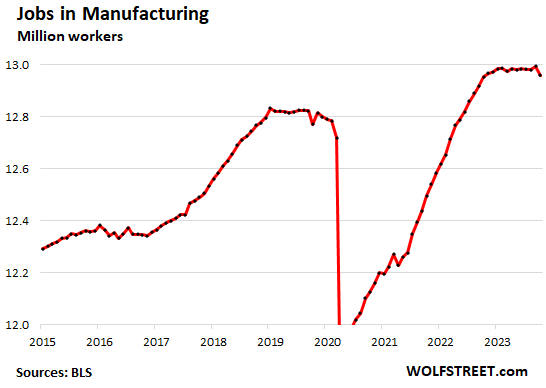
Employers added 150,000 workers to their payrolls in October, according to the BLS survey of employers. Without strikes in the auto sector, employment might have increased by over 180,000.
Either one was below the three-month average of 204,000 workers. In 2019, the three month-average of net job gains was running between 100,000 and 200,000.
The chart shows the three-month average that irons out some of the month-to-month ups and downs:
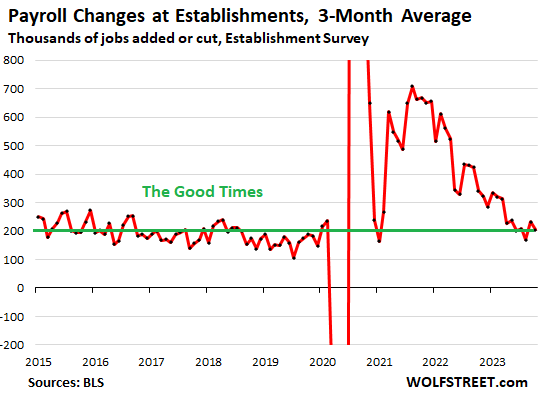
Total employment by employers rose to a record 156.9 million workers.
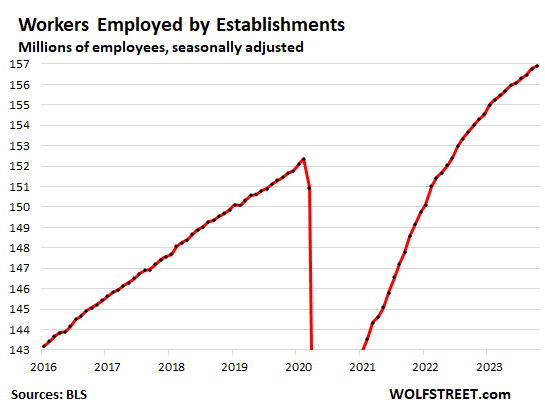
Part-timers plunge, self-employed drop, but workers with salaries and wages rise.
The total number of workers – including workers with salaries and wages employed by employers, self-employed workers, and part-time workers – dropped by 348,000, driven by a 670,000 plunge in part-time employment, and a 90,000 drop in self-employment. This data come from BLS survey of households, not of establishments, and captures those workers who are not employed by establishments.
The number of workers on salaries and wages rose by 64,000 workers to 150.2 million, after a dip in the prior month, per the survey of households.
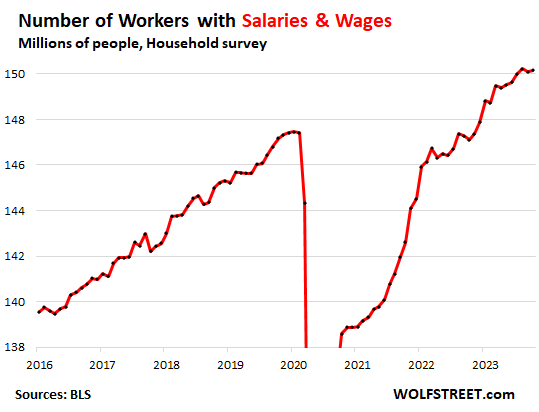
But the number of part-time workers plunged by 670,000, the biggest plunge since the collapse in April 2020.
Turning part-time workers into full-time workers — those who want to work full-time — would be a good thing. But before we get all excited about it, these numbers are seasonally adjusted to balance out the big seasonal variations in part-time employment, and those seasonal adjustments can easy go awry. That’s why we look at this stuff with long-term charts so we can see.
The BLS defines part-time work as 34 hours per week or less.
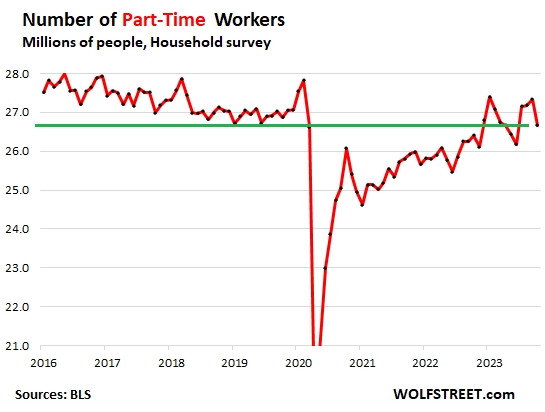
As the above chart shows, part-time employment is lower than it was before the pandemic in absolute numbers.
But part-time employment as a percentage of total employment has been on a long uneven downtrend. In October, the three-month moving average (which irons out some of the month-to-month variability) dipped to 16.8% of total workers. In 2016, it was still above 18%. This long-term trend contradicts the silly meme that the US economy just keeps creating part-time barista jobs.
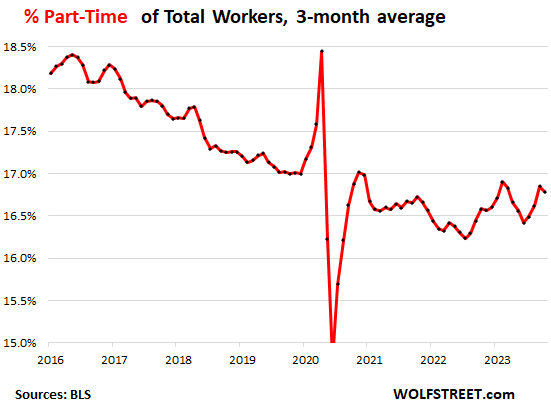
And the number of self-employed dropped by 43,000 workers. The pandemic had created a burst of self-employment that has been tapering off and has returned to pre-pandemic levels:
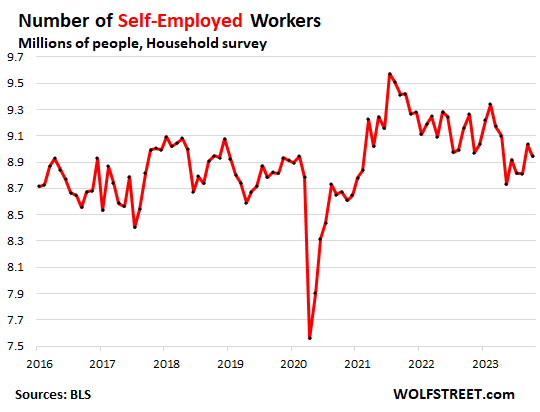
Self-employment as a percentage of total employment has dropped to the low end of the range before the pandemic, with the three-month moving average in October at 5.5%:
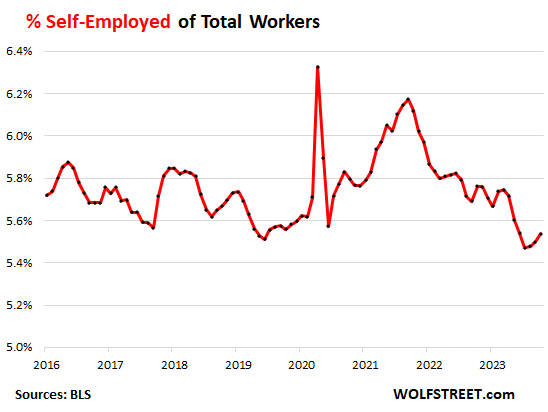
Average hourly earnings of Production and Nonsupervisory Employees in the private sector – the vast majority of private-sector employees, ranging from coders to factory workers – rose by 0.34% in October from September, the biggest increase in four months. This translates into an annualized increase of 4.2%.
Compared to a year ago, average hourly wages rose by 4.4%. You can see how the rate of wage increases is now stabilizing in this 4%-plus neighborhood, after the pandemic chaos. And the wage increases remain far higher than before the pandemic.
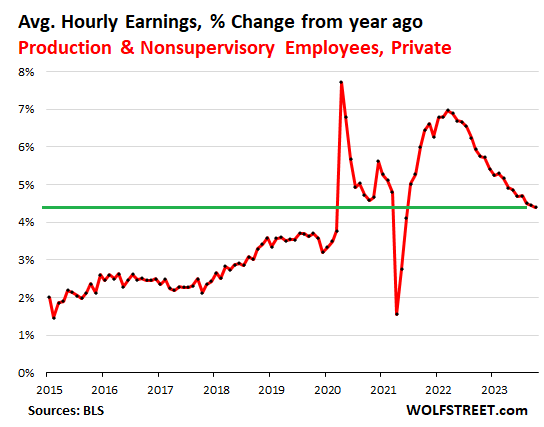
Oh, and the number of multiple jobholders rose in October to 8.356 million, almost as high as in July 2019 (8.383 million).
But the total number of workers has grown over the months and years. Over the past four decades, the number of workers has grown by about 40 million, along with the population. And so the number of multiple job holders as a percent of total jobholders over the years actually dropped.
Multiple job holders as percent of all workers, at 5.2% in October, was where they had been in October 2019, both of them historically relatively low: In the 1990s it was over 6%. The chart shows the three-month-moving average:
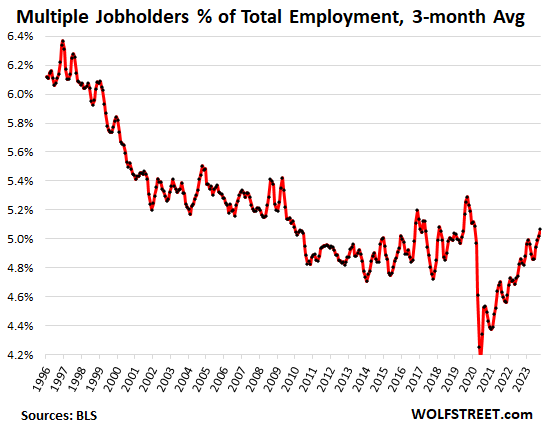
Enjoy reading WOLF STREET and want to support it? You can donate. I appreciate it immensely. Click on the mug to find out how:
![]()


Wolf, can you please comment on why there is roughly a 7 million difference between the household survey and the establishment number? Thank you.
1. Different surveys, different metrics, can never be compared.
2. The household surveys count all people who are working, no matter what work they do or how they get paid. Gig workers are included, self-employed are included, people getting paid cash are included, everyone is included.
3. The establishment survey only counts people who get a paycheck by an “establishment” — a company, government, or nonprofit. So these are the people who are on the payrolls, get employment taxes deducted, etc.
The Fed mentioned that immigration is now playing a large role in keeping labor supply strong. I assume the Fed is referring to legal immigration, and not illegal immigration. It would be interesting to see know many jobs are being filled by immigrants to dispel unsubstantiated claims and propaganda we hear about immigration from both sides. For example, a chart could show total jobs added each month to immigration totals each month, over time.
Not requesting it or expecting it. Just throwing it out there.
This employment data does not distinguish between workers who are legally in the US and workers who are illegally in the US. As far as the data is concerned, a worker is a worker.
I doubt I can keep this thread up for long. I never can. The topic of immigration brings out the worst stuff.
On a related note. Are the grifters at intersections a liability risk to drivers?
I was wondering that today. They are at almost every major intersection here in NC.
I also just hope they are not apart of some pyramid grifting scheme. Do all the leg work and the lazy grifter gets half your booty! Arggghhh matey
WTF are you talking about?
Hope I can tell my funny (to me) story more clearly.
So maybe in 2007-010 or so (back when I watched a hell of a lot of CNBC to learn Econ 101, because for the first and last time in my life I had about $70K cash, after paying everyone I had to pay when I sold the off grid house I started in 1990, still unfinished), this chicken bandsawing factory (in, where else, Texas) got busted for a bunch of employees with no legal work papers of any kind. The owner was really mad as hell about all the penalty fines he had to pay, and said the government used to take care of that for him, so he could just hire those with whatever papers, but no longer do, and just how the in the hell was he supposed to figure all that out by himself and run a chicken bandsawing factory, too?
Busy-ness men have a tough life, eh?
Guess that’s what they mean by “hard earned money”.
Oh yeah, who was the grifter in my story?
Immigration (legal + illegal) is impossible to measure with any reasonable accuracy, so its effects are thus impossible to assess. Throw in the “black market” (including all crime, and maybe especially the illegal drug trade which from news reports is sizeable) and you end up with a real mess to analyze, as Wolf suggests.
If we assume this “mess” is fairly constant over time or increasing at a fairly constant rate or decreasing at a fairly constant rate, or that it is a small factor (I doubt that), then what is left is the variation in LEGAL labor data, which may be what we are seeing, and can perhaps be analyzed.
I’m actually wondering if you’ve a filter set specifically around the word `immigrat*` .. lol
Wolf completely agree, so if you don’t put up this post or take it down immediately no hard feelings. My experience with immigrants both illegal and legal has been frustration with the way our politicians on both sides of the isle treat the issue because there needs to be a major overhaul of the immigration system but neither side will touch it with a ten foot pole. And our country has a double standard as we say that we both want you here for cheap labor, to fill the less than desirable jobs, and leave the door wide open, at the same time we say we don’t want you here, denying good men and women the opportunity to work legitimately and to benefit from working legitimately. It is a no win situation for many of these people. I had a guy was a stud and who had lived in the US illegally for 25 years, been married for 20 years to an American and had three kids all who are American citizens . As a company we wanted to help him get citizenship so we consulted a lawyer. Lawyer told us he would have to go back to Mexico for 10 years and then seek to apply for citizenship. That made no sense. We told him stay here and continued to employ and pay him well! Loved that guy!!! I don’t think we should be advocating for illegal immigration but at the same time I don’t blame them because we don’t have a system that is fair and clear. Most want to come and make a living and life. It is so much murkier and muddled than people and politicians make it to be.
This is one of my soap boxes so if it’s unhelpful take it down Wolf. My goal is not to inflame conversation. Just to give a perspective that sees the convoluted nature of our immigration system.
The glove (or whatever it is) has been thrown on the ground.
The WS Commentistas are being tested!
I meant to say “Challenged” rather than “tested”….as in serious shit!
GAUNTLET!
Why does the word come to me much later…..senility, I ‘spose.
To clarify, is weak influx of workers keeping the labor markets tight? What about outflux of workers, retirement etc., loss of life etc?
Could we get the same signal from just looking at total number of people looking for jobs and side-step the question of who is who?
I think the unemployment rate gives the reason for why labor market is tight and not the symptom of it. It ticked up to 3.9%. Still a fully employed economy.
So if jobs and wages are still growing, even slowly, any recession is still a ways off according to traditional measures.
sounds like it. Even if 10 yr yields were to hold 5% or mortgage rates go to 9% – doesn’t make a lot of difference to spending habits from 4.5% / 8%.
I’m just amazed at how overstimulated the economy was and how much worse inflation could have been.
I keep hearing about the lag / delayed effect of monetary policy – but wages and unemployment are holding strong.
Let’s see who blinks first.
I’d be surprised if there is not accurate data on work visas issued. Wouldn’t that be proxy for legal immigration? That said, it definitely adds a supercharged social element that would probably dominate the macro discussion.
Sorry, meant as reply to William.
1) NDX 1W : the bar twice size, same vol. Something is wrong. Aug 28 to Oct 9 highs.
2) NDX 1M : in order to move higher NDX must close above Oct high.
3) NDX 1D : something is wrong with today close, despite the effort.
4) SPX, same bs.
Interesting that you struggle with the volume . Could the reason be an evaporation of sellers ? Just guessing I have no idea. Your comments have been missed lately . The same issue in the bond market I would expect who the heck was buying the bonds? Maybe short covering ?
Multiple job holders as a percent of total employment is pretty low which is surprising. I’m always hearing about how many people have to work multiple jobs to make ends meet but that is not so, according to the data.
As a self employed project manager, I like the variety of having more than one 1099 employer. With only one employer, they have most of the control and frequently use it to their advantage.
Not necessarily to make ends meet but to get a second cash flow or work on an investment. You work for Google as an engineer, and make $250k a year plus a gazillion in stock options, and on the side, you own rental property that you also manage. So now you’re a multiple jobholder. There are lots of them.
It’s just that there are 161 million working people, so the percentage is pretty small.
A story just came out today in fortune. A engineer and wife moved from NC to NH. Sold their house in NC. Had 700k (with mortgage) to buy with. Couldn’t find anything they can afford and are having to rent a 1750 Sq. Ft house with their kids for $3500 a month.
Their old house in Nc is we 3000+ Sq ft.
They clear 200k a year. $42,000 to rent, $20,000 to daycare so the wife can work at home. The rest of the salary is eaten up with other bills.
Doubt they are saving much.
Bummer
Yes, you can ALWAYS outspend your income, no problem. It’s pretty easy to do. You can make $1 million a year and outspend your income, no sweat. This world is designed to make it easy and convenient for you to outspend your income.
Going against the flow and not outspending it is hard — especially for people who were born with a silver spoon in their mouth and never went through any real hardship.
A person that I consider to be fairly reasonable posted today after the jobs numbers were released “The much more accurate and less manipulated Household survey shows employment collapsed by 348K, the biggest drop since the Covid shutdown. It’s almost certain the US is already in recession.” I think he is not correct. Wolf, I presume that you do not think that the US is in a recession.
Harry,
RTGDFA. ALL of it. And read this section twice: “Part-timers plunge, self-employed drop, but workers with salaries and wages rise.” This section contains the number you cite and tells you something about it.
Then come back down here, apologize, and explain to us what you learned from the article about this figure.
Just kidding about the “apologize,” but not about the rest.
You people drive me nuts with this stuff. I now blacklist all commenters who drag some shit into here that they read somewhere else without obviously having read the article.
Commenting guideline #1: Do NOT comment on the topic of the article unless you read the ENTIRE article.
Wolf buddy, friend, pal.
Perhaps a walk to the bay is due?
Smell the chilly bay air. Grab some take out. Slap a sticker onto an automated car.
:)
Fundamental indicator drops:
Maersk. world’s largest cargo ship line is laying off 10K or about 10% of workers as rates and volume on containers drops. This is a global bellwether.
To have a soft landing, you must first descend. In the air or in this tightening space, after 40 yrs of falling interest rates, now reversed, one thing is certain: there will be contact with ground, softly or otherwise.
If the stock market continues to ignore fundamentals like the major move in shipping, and refuses to descend towards a soft landing, we may see a hard landing, or 25% in one session. The last time that happened in eighty seven, there was a quick recovery, but things are way more frothy now, with vastly higher debt.
Did you miss the part where the economy shifted from goods to services, after the boom in goods during the pandemic? Goods related sectors, including transportation, are down, prices of goods are falling. That has been going on for over a year, and we documented it right here. Maersk is just slow in reacting to it.
What’s hot are services, and services don’t have to be transported by ship. Price increases in services are red-hot too. That’s where inflation is (this is US data, not sure about Canada).
Agree Maersk is slow. But with the Dow up 500 in one day because the Fed didn’t raise rates, the stock market looks not just slower to grasp fundamentals, but not ‘getting it’ at all.
I may be old fashioned in thinking that production of goods is a more fundamental measure of an economy’s health than many services, like folks wanting someone to cook their food, and a now multi- billion dollar outfit to deliver it.
Right now it is China that is feeling the pain as goods production falls and so does its shipping to us. After the GFC, China’s credit expansion was the largest in history. This is now contracting.
A fundamental that the stock market is not getting.
Nick Kelly,
I trade frequently. This rally is probably a trade. The tax loss selling will likely end it if fundamentals don’t first.
Stock market pros are not ignoring anything. The pros are planning on handing off to the late to arrive, to people who don’t understand the market. At least that is what I am planning on. That and raising my balance by 2-10%. That is the game as I understand it so far.
Wolf: When I gaze at the Total employment by employers and salaried workers charts, I notice that the number was increasing at an annual rate of 2M from 2016 to 2020 but got reduced to around one million a year from 2020 to 2023 (ignoring the pandemic dip).
Perhaps our fertility rates are going down, immigrant numbers are going down (USA is no longer the desired destination with oil countries taking in more) or folks are retiring in higher numbers (I thought the baby boomers retirement window is long gone as I am one of them).
Thanks.
The rate of growth coming out of the pandemic has been far higher than 2 million a year, and far higher than it was before the pandemic. Even over the last three months, employment growth averaged a rate of 2.4 million a year.
“(I thought the baby boomers retirement window is long gone as I am one of them).”
The youngest boomers, born in 1964, aren’t even 60. I think the retirement window for boomers will be open for a long time unless I misunderstand what you mean.
Sorry, posted my comment before I saw yours.
Plenty of boomers working into their 70s. I know several. Many more would like to work but those with salary positions and office jobs are not considered in the hiring process as age is a big factor in longevity.
The peak of the boomer population retiring at 65 y.o. was last year. So we’ve got a fair amount of retirement run-off ahead still, along with the splurge retirees do after they first retire. Plus the pandemic stimulus run-off, so I don’t expect our drunken sailors to ease up for a year or two yet.
Youngest baby boomers are only 59.
Seeing the data have pandemic shocks then coming back in line with old trends is neat. I think I always observe the chaos and worry but this is fun to see some prepandemic trends resume course. Even when we go to hell in a hand basket in 2020…thanks wolf for the late Friday night reading.
As a result of the pandemic, Ms Swamps hairdresser now operates mostly out of her home. She gets $85 for a complete root treatment vs $300 at the mall salon. Payment is in cash. I don’t think this data is captured by any of the surveys, household or establishment. One thing for sure, this is accelerating the demise of these already bankrupt shopping malls as customers take their business elsewhere.
Swamp – have always wondered at the correction factor the relevant agencies must run to account for those who observe the Eleventh Commandment and keep it Wholly…
may we all find a better day.
Amen!
situational awareness and situational ethics!
They are built in (to most people)
How do you think we invented gods and “thinking itself”
“I think therefore I must eat and shit”- De Carbon
You would think that many analysts are jumping the gun when they say there won’t be any more rate hikes as the numbers will bounce – as the article states – when the strikes are fully over.
Powell alluded to this. Was very good news for the equity rally on Friday.
I am saying equities are in a strong rally rather than a bull market until a lot more evidence of a bull emerges. My guess is this rally will fizzle with tax selling and equities and bonds are still in muddle-thru.
The trick with rallies is to get in early and not stay late (be left holding the bag). Selling at a profit even if much to early is still a win.
Average weekly hours worked continue to drop. Dave “Rosy” Rosenberg indicator of recession.
https://fred.stlouisfed.org/series/AWHAETP
LOL. The BS just keeps piling up, doesn’t it?
1. “Continue to drop” is lie. LOOK at the chart you linked. From March on, so for 8 months, they have been either 34.4 or 34.3 hours, one month this, the next month that, along a horizonal line.
2. They’re right back where they had been in 2019 during the Good Times when they averaged 34.4 hours.
3. They’re normalizing to Good-Times levels in 2019, off the pandemic boom.
4. This kind of BS is why recession-mongers have been wrong for 18 months. Because they don’t actually look at what’s there. The let their imagination run wild.
It is odd to actually link a chart that doesn’t support what you say. Do you think other people can’t read a chart? Are you not able to read a chart? It’s a head scratcher.
Yes, I don’t get that. But it’s fairly common.
Charlie Bilello
The US Unemployment Rate moved up to 3.9% in October, highest since Jan 2022. April’s 3.4% reading was the lowest reading since 1969.
Historically, that 0.5% move higher has occurred near the start of a recession…
The rule, hatched by former Federal Reserve economist and now Bloomberg columnist Claudia Sahm, posits the start of a recession when the three-month moving average of the unemployment rate rises by a half-percentage point or more relative to its low during the previous 12 months
My note: I’ve seen this indicator before she took credit…lol. And when it drops .5, it’s the start of a recovery.
But the NBER won’t recognize the start of a recession till well after it has started (or ended).
Good ol’ Charlie Bilello has been recession-mongering for over a year. So someday he’ll be right for sure, because there is always a recession sooner or later. But I don’t think the time is ripe yet.
For your amusement, I just googled it: his recession tweets go way back. Here are a couple of examples. In Oct 2022, over a year ago, he already was recession-mongering.
Oct 2022:
https://twitter.com/charliebilello/status/1580550011456454662
And here in Dec 2022:
https://twitter.com/charliebilello/status/1605947112331640832
About the unemployment rate: The increase from 3.8% (prior two months) to 3.9% was caused by the strikes of the autoworkers which threw 33,000 people out of work in October, according to the BLS itself (you gotta read the BLS report, or at least RTGDFA here).
We had HUGE 4.9% GDP growth in Q3. That’s not going to get repeated, that was way above the normal growth rate for the US of about 1.9%. So growth will be a lot lower in Q4 than 4.9% growth, that’s for sure, part of that is just math in the way that these quarter-to-quarter comparisons work where the huge 4.9% growth in Q3 becomes the base for Q4.
So growth is going to be a slower in Q4 than Q3, but a recession isn’t slower growth – it’s an actual broad economic decline. And so far, that’s just not happening. We here have been on recession watch for 18 months, and we haven’t given up yet. Someday we’re going to get one. But consumer and government spending have got to keel over, and they just haven’t yet.
One can shoot the messenger. Or recognize that 3.4% unemployment was last achieved in 1969 and that a .5% move would appear to be a change in trend.
Further GDP and unemployment rates are lagging economic indicators.
Everyone spends until they can’t through increased revolving credit with individuals or deficit spending by the govt. No mystery there
When the yield curve uninverts, THAT is the time to be worried.
You are not at ALL like that very nice man above who ministered to Wolf when he sensed he was in mental pain from the extra effort of shooting “messengers”, ESPECIALLY when he could easily just delete them entirely with a button push.
Maybe reading Fortune makes one a kinder more empathetic person towards the less fortunate, like in the stories he tells? And more so when obviously one starts reading it at a very young age.
Number of workers was on a pretty steady linear trend before the pandemic. Looks like it’s still about 5M or so behind that trend. How important is that?